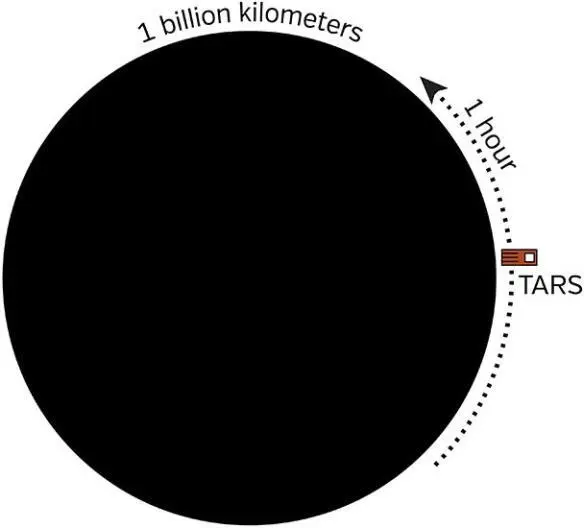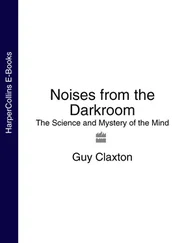
Fig. 6.2. TARS, falling into Gargantua, is dragged around the hole’s billion-kilometer circumference once each hour, as seen from afar.
In 1975, I discovered a mechanism by which Nature protects black holes from spinning faster than the maximum: When it gets close to the maximum spin, a black hole has difficulty capturing objects that orbit in the same direction as the hole rotates and that therefore, when captured, increase the hole’s spin. But the hole easily captures things that orbit opposite to its spin and that, when captured, slow the hole’s spin. Therefore, the spin is easily slowed, when it gets close to the maximum.
In my discovery, I focused on a disk of gas, somewhat like Saturn’s rings, that orbits in the same direction as the hole’s spin: an accretion disk (Chapter 9). Friction in the disk makes the gas gradually spiral into the black hole, spinning it up. Friction also heats the gas, making it radiate photons. The whirl of space around the hole grabs those photons that travel in the same direction as the hole spins and flings them away, so they can’t get into the hole. By contrast, the whirl grabs photons that are trying to travel opposite to the spin and sucks them into the hole, where they slow the spin. Ultimately, when the hole’s spin reaches 0.998 of the maximum, an equilibrium is reached, with spin-down by the captured photons precisely counteracting spin-up by the accreting gas. This equilibrium appears to be somewhat robust. In most astrophysical environments I expect black holes to spin no faster than about 0.998 of the maximum.
However, I can imagine situations—very rare or never in the real universe, but possible nevertheless—where the spin gets much closer to the maximum, even as close as Chris requires to produce the slowing of time on Miller’s planet, a spin one part in 100 trillion less than the maximum spin. Unlikely, but possible.
This is common in movies. To make a great film, a superb filmmaker often pushes things to the extreme. In science fantasy films such as Harry Potter , that extreme is far beyond the bounds of the scientifically possible. In science fiction, it’s generally kept in the realm of the possible. That’s the main distinction between science fantasy and science fiction. Interstellar is science fiction, not fantasy. Gargantua’s ultrafast spin is scientifically possible.
Gargantua’s Anatomy

Having determined Gargantua’s mass and spin, I used Einstein’s equations to compute its anatomy. As in the previous chapter, here we focus solely on the external anatomy, leaving the interior (especially Gargantua’s singularities) for Chapters 26 and 28.
In the top picture in Figure 6.3, you see the shape of Gargantua’s equatorial plane as viewed from the bulk. This is like Figure 5.5, but because Gargantua’s spin is much closer to the maximum possible (one part in 100 trillion contrasted with two parts in a thousand in Figure 5.5), Gargantua’s throat is far longer. It extends much farther downward before reaching the horizon. The region near the horizon, as seen from the bulk, looks like a long cylinder. The length of the cylindrical region is about two horizon circumferences, that is, 2 billion kilometers.

Fig. 6.3. Gargantua’s anatomy, when its spin is only one part in 100 trillion smaller than the maximum possible, as is required to get the extreme slowing of time on Miller’s planet.
The cylinder’s cross sections are circles in the diagram, but if we were to restore the third dimension of our brane by moving out of Gargantua’s equatorial plane, the cross sections would become flattened spheres (spheroids).
On Gargantua’s equatorial plane I marked several special locations that occur in my science interpretations of Interstellar : Gargantua’s event horizon (black circle), the critical orbit from which Cooper and TARS fall into Gargantua near the end of the movie (green circle; Chapter 27), the orbit of Miller’s planet (blue circle; Chapter 17), the orbit in which the Endurance is parked while the crew visit Miller’s planet (yellow circle), and a segment of the nonequatorial orbit of Mann’s planet, projected into the equatorial plane (purple circle). The outer part of Mann’s orbit is so far away from Gargantua (600 Gargantua radii or more; Chapter 19) that I had to redraw the picture on a much larger scale to fit it in (bottom picture), and, even so, I didn’t do it honestly: I only put the outer part at 100 Gargantua radii instead of 600 as I should. The red circles are labeled “SOF” for “shell of fire”; see below.
How did I come up with these locations? I use the parking orbit as an illustration here and discuss the others later. In the movie, Cooper describes the parking orbit this way: “So we track a wider orbit of Gargantua, parallel with Miller’s planet but a little further out.” And he wants it to be far enough from Gargantua to be “out of the time shift,” that is, far enough from Gargantua that the slowing of time compared to Earth is very modest. This motivated my choice of five Gargantua radii (yellow circle in Figure 6.3). The time for the Ranger to travel from this parking orbit to Miller’s planet, two and a half hours, reinforced my choice.
But there was a problem with this choice. At this distance, Gargantua would look huge; it would subtend about 50 degrees on the Endurance ’s sky. Truly awe inspiring, but undesirable for so early in the movie! So Chris and Paul chose to make Gargantua look much smaller at the parking orbit: about two and a half degrees, which is five times the size of the Moon as seen from Earth—still impressive but not overwhelmingly so.
The Shell of Fire

Gravity is so strong near Gargantua, and space and time are so warped, that light (photons) can be trapped in orbits outside the horizon, traveling around and around the hole many times before escaping. These trapped orbits are unstable in the sense that the photons always escape from them, eventually. (By contrast, photons caught inside the horizon can never get out.)
I like to call this temporarily trapped light the “shell of fire.” This fire shell plays an important role in the computer simulations (Chapter 8) that underlie Gargantua’s visual appearance in Interstellar .
For a non spinning black hole, the shell of fire is a sphere, one with circumference 1.5 times larger than the horizon’s circumference. The trapped light travels around and around this sphere on great circles (like the lines of constant longitude on the Earth); and some of it leaks into the black hole, while the rest leaks outward, away from the hole.
When a black hole is spun up, its shell of fire expands outward and inward, so it occupies a finite volume rather than just the surface of a sphere. For Gargantua, with its huge spin, the shell of fire in the equatorial plane extends from the bottom red circle of Figure 6.3 to the upper red circle. The shell of fire has expanded to encompass Miller’s planet and the critical orbit, and much, much more! The bottom red circle is a light ray (a photon orbit) that moves around and around Gargantua in the same direction as Gargantua spins (the forward direction). The upper red circle is a photon orbit that moves in the opposite direction to Gargantua’s spin (the backward direction). Evidently, the whirl of space enables the forward light to be much closer to the horizon without falling in than the backward light. What a huge effect the space whirl has!
Читать дальше















